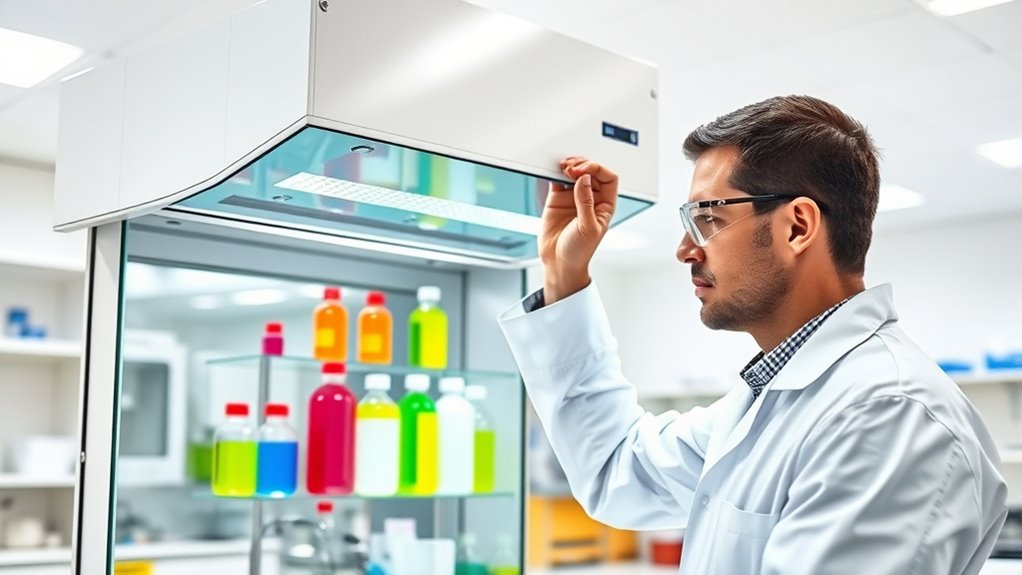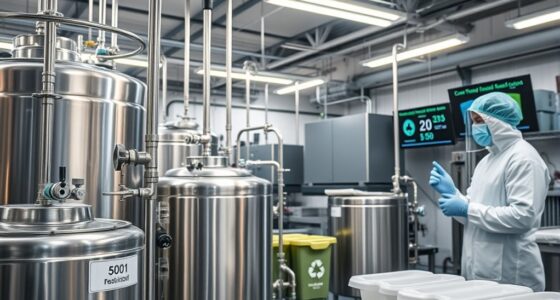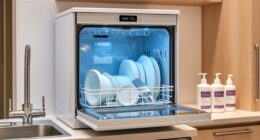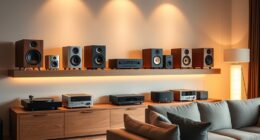To practice energy-efficient fume hood use, keep the sash at the lowest safe height to reduce airflow and save energy. Regularly maintain and inspect filters, monitor airflow rates, and guarantee proper sash positioning. Use advanced systems like Variable Air Volume (VAV) controls and sensors to adjust airflow based on actual needs. Consistently training yourself on best techniques and monitoring performance helps prevent waste and boosts safety—discover more simple strategies to optimize your lab environment.
Key Takeaways
- Adjust sash height to the lowest safe position to reduce airflow volume and energy consumption.
- Regularly maintain and calibrate airflow systems and sensors to ensure efficient operation.
- Use variable air volume (VAV) systems to dynamically control airflow based on lab activity levels.
- Keep sash clean, aligned, and lowered when not in use to minimize unnecessary airflow and energy waste.
- Employ airflow visualization and monitoring to detect leaks, turbulence, and ensure proper ventilation efficiency.
Optimizing Sash Position for Energy Savings
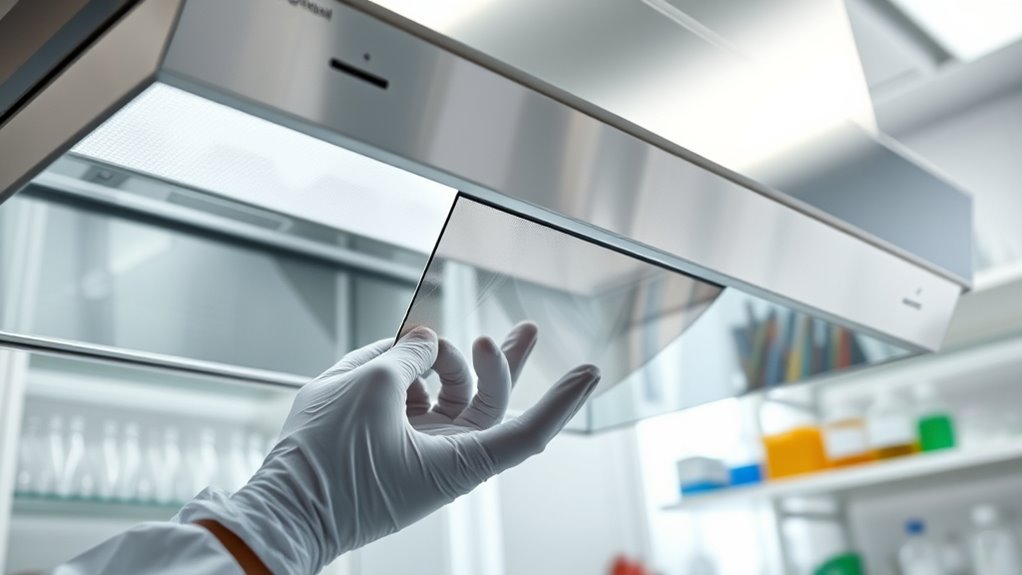
While it might seem minor, adjusting the sash height on your fume hood can considerably reduce energy consumption. Proper sash height adjustment ensures maximum airflow regulation, which is key to energy efficiency. When you lower the sash, you reduce the open area, decreasing the volume of air that needs to be exhausted constantly. This minimizes the fan’s workload and cuts energy use. Conversely, raising the sash too high wastes energy by allowing excess airflow. You should position the sash at the lowest possible height that still provides safe access to your work area. Regularly checking and adjusting the sash height helps maintain proper airflow regulation, ensuring you use only the necessary energy. Small adjustments can lead to significant savings over time, making your lab more sustainable. Enduring love and legacy can serve as a reminder to practice energy efficiency consistently for long-term benefits. Additionally, understanding the environmental considerations surrounding your lab operations encourages more mindful energy practices. Incorporating best practices from industry standards can further optimize your energy efficiency efforts.
Regular Maintenance and Filter Checks
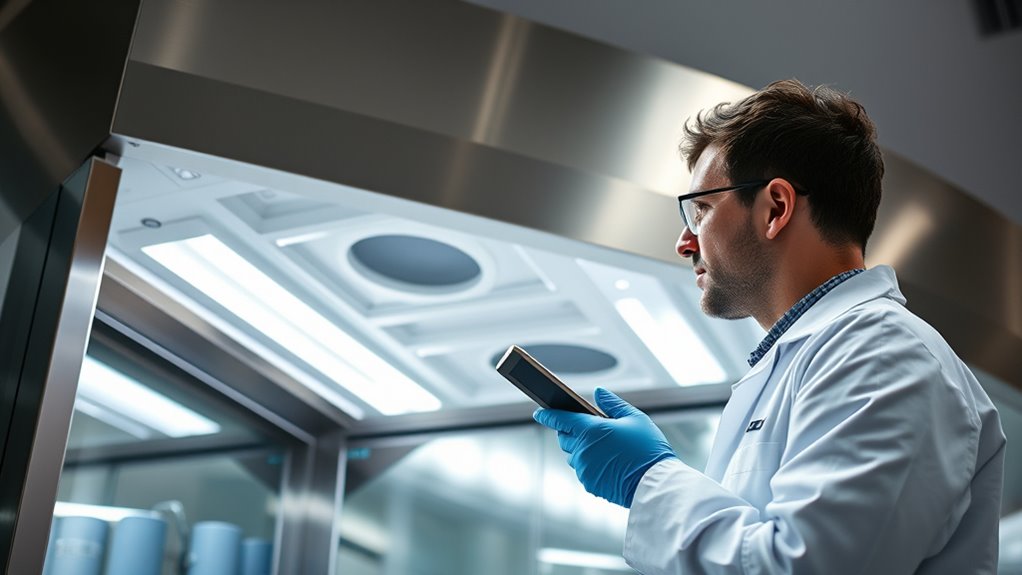
Regular maintenance and filter checks are vital for keeping your fume hood running efficiently. You should regularly inspect filters and replace them when they become clogged or damaged to guarantee proper containment and airflow. Neglecting filter replacement can lead to reduced airflow and compromised safety. Additionally, airflow calibration is essential; over time, airflow can drift from ideal levels, so you need to verify and adjust it periodically. Proper calibration ensures the hood operates at the correct face velocity, minimizing energy waste while maintaining safety standards. Keep a maintenance schedule to track filter replacements and airflow checks. Regular upkeep not only prolongs your fume hood’s lifespan but also preserves energy efficiency by preventing unnecessary airflow fluctuations, helping you reduce costs and guarantee a safe, effective working environment. Monitoring airflow levels regularly is also crucial to detect any deviations early and maintain optimal performance. Incorporating filter condition assessments can further enhance the efficiency and safety of your system.
Implementing Variable Air Volume (VAV) Systems

Implementing Variable Air Volume (VAV) systems can substantially enhance your fume hood’s energy efficiency by adjusting airflow based on actual usage. With VAV, you optimize airflow by reducing unnecessary exhaust when full airflow isn’t needed, preventing energy waste. This method allows for precise airflow control, ensuring the fume hood only consumes energy when in use, which improves overall energy management. By integrating VAV systems, you can respond dynamically to lab activity levels, maintaining safety while cutting energy costs. Proper implementation involves calibrating the system to match your lab’s specific needs, ensuring airflow is neither excessive nor insufficient. Overall, VAV systems provide an effective way to optimize airflow, reduce energy consumption, and promote sustainable research practices.
Using Automated Controls and Sensors
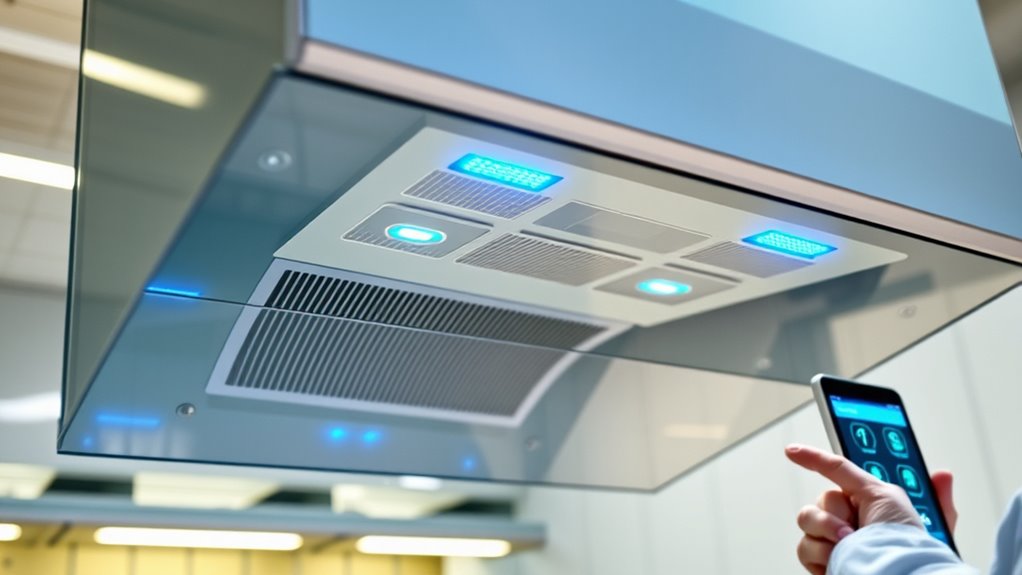
Automated controls and sensors help optimize fume hood operation by adjusting airflow based on real-time needs. You can set the system to activate ventilation only when necessary, saving energy and reducing waste. Monitoring these systems guarantees they work efficiently and alert you to any issues immediately. Incorporating energy-efficient practices into your laboratory setup can further reduce environmental impact and operational costs. Additionally, implementing AI-driven safety measures can enhance the responsiveness and reliability of fume hood systems, ensuring optimal performance.
Automatic Air Volume Adjustment
By using automated controls and sensors, fume hoods can dynamically adjust their air volume to match real-time laboratory conditions. This process relies on precise airflow calibration to ensure the hood maintains a safe environment while reducing unnecessary airflow. When the sensors detect changes in lab activity or sash position, the system automatically modifies the exhaust and supply rates, preventing excessive energy use. Proper hood sealing is essential for these adjustments to be effective; leaks can compromise airflow accuracy and safety. Enhanced natural language processing enables more accurate detection of lab activity changes, further improving system responsiveness. With automatic air volume adjustment, you optimize energy efficiency without sacrificing protection. This technology helps maintain consistent performance, minimizes airflow fluctuations, and reduces energy costs—making your lab safer and more sustainable. Additionally, understanding airflow calibration is crucial for ensuring the system functions correctly and maintains safety standards.
Sensor-Activated Ventilation
Sensor-activated ventilation enhances fume hood efficiency by using automated controls and sensors to monitor real-time laboratory conditions. These systems adjust airflow based on factors like sash position, work activity, and air quality, reducing energy waste while maintaining safety protocols. When sensors detect lower contaminant levels or an empty sash, airflow decreases, saving energy without compromising safety. To illustrate, consider the table below showing different sensor types and their functions:
| Sensor Type | Function | Benefits |
|---|---|---|
| Air Quality Sensor | Detects contaminants and fumes | Ensures ideal safety |
| Sash Position Sensor | Monitors sash height | Adjusts airflow accordingly |
| Motion Sensor | Detects lab activity | Reduces airflow when inactive |
| Light Sensor | Optimizes lighting and airflow | Saves energy |
Using these sensors ensures better air quality, energy savings, and compliance with safety protocols. Additionally, understanding the effectiveness of sensor technology can help optimize laboratory operations further, especially when integrating tuning strategies for energy efficiency. Incorporating regular maintenance practices is also vital to sustain sensor performance and overall system reliability.
Real-Time System Monitoring
Real-time system monitoring leverages automated controls and sensors to continuously track laboratory conditions and respond instantly to changes. This technology helps you maintain ideal air quality and reduce energy consumption by automatically adjusting fume hood operations. With real-time feedback, you can prevent unnecessary airflow, saving energy while ensuring safety. Sensors detect fluctuations in air quality, triggering adjustments that maximize ventilation only when needed. Automated controls can also alert you to issues immediately, minimizing downtime and energy waste. This system enhances safety, improves efficiency, and reduces operating costs. Additionally, using vetted home theatre projectors can optimize space and energy efficiency in laboratory environments by reducing the need for large, energy-consuming equipment. Incorporating personal development techniques such as mindfulness and goal setting may also improve decision-making and responsiveness when managing automated systems.
Training Researchers on Best Practices
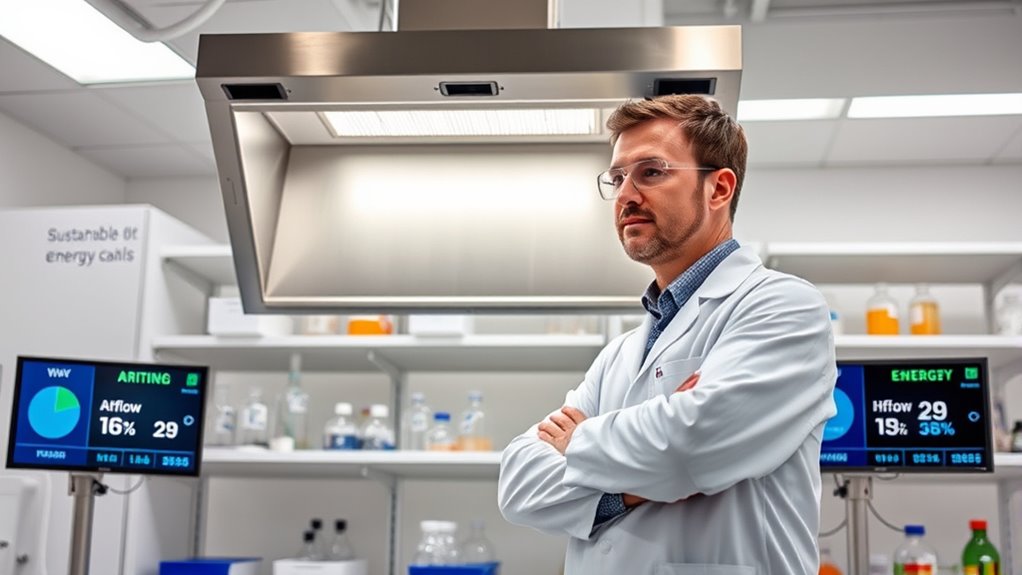
You need to guarantee researchers know the proper hood usage techniques to minimize energy waste. Teaching them how to recognize ventilation signs helps prevent unnecessary operation and potential safety issues. Regular maintenance training keeps the fume hoods functioning efficiently and extends their lifespan.
Proper Hood Usage Techniques
To maximize energy efficiency and guarantee safety, researchers must master proper fume hood usage techniques. Understanding airflow patterns helps maintain containment and reduces energy waste. Keep the sash at the lowest comfortable position to optimize airflow and minimize energy loss. Proper sash ergonomics ensures ease of access and reduces strain during use. Always keep the sash clean and properly aligned to prevent airflow disruptions. Avoid leaning into the hood or blocking vents, which can compromise containment and increase energy consumption. Regularly train on best practices so you can quickly identify and correct improper habits. Implementing these techniques maintains airflow efficiency, enhances safety, and conserves energy. Small adjustments in usage make a significant difference in the overall performance and sustainability of your laboratory environment. Additionally, understanding airflow patterns can help optimize hood performance and prevent energy waste.
Recognizing Ventilation Signs
How can researchers tell if their fume hood is ventilating properly? One key sign is observing airflow patterns. A steady airflow pulls contaminants away from your workspace, ensuring safety and efficiency. You should see smooth, consistent airflow without turbulence or dead zones. To visualize this, consider the following:
| Airflow Pattern | Hood Ergonomics | Signs of Proper Ventilation |
|---|---|---|
| Steady airflow | Properly positioned sash | Air moves in a consistent flow |
| No turbulence | Comfortable working height | No unexpected drafts or noise |
| Uniform flow | Easy access to controls | No odors escaping the hood |
| Clear air movement | Adequate workspace design | No fogging or buildup inside |
Additionally, maintaining proper sash height is crucial for optimal airflow and safety. Regularly checking refrigeration cycle efficiency can help prevent malfunctions that might compromise hood ventilation. Recognizing these signs ensures your hood functions efficiently, maintaining safe, ergonomic working conditions.
Regular Maintenance Procedures
Regular maintenance is essential to guarantee your fume hood continues to operate safely and efficiently. Proper upkeep ensures ideal airflow, reduces energy waste, and prevents hazards. Training researchers on best practices helps maintain consistent performance. Regularly check fume hood labeling to confirm it’s functioning correctly and clearly marked. Use airflow visualization techniques to identify any airflow disruptions or leaks. Keep filters clean and replace them as needed to maintain proper airflow. Schedule routine inspections for damage or wear, and verify the sash moves smoothly. Educate staff on the importance of reporting issues immediately. Incorporating proper ventilation practices ensures optimal performance and safety. These steps help sustain energy-efficient operation and ensure safety for everyone working in the lab. Staying proactive reduces downtime and prolongs the life of your fume hood.
Monitoring and Analyzing Fume Hood Usage

Effective monitoring and analysis of fume hood usage are essential for maximizing energy efficiency and ensuring safety. By tracking airflow patterns, you can identify inefficiencies that waste energy or compromise contamination control. Using sensors and data loggers helps you gather real-time information on hood performance, enabling prompt adjustments. Regular analysis reveals usage trends, so you can optimize sash positions and airflow rates, reducing energy consumption without sacrificing safety.
| Usage Parameter | Recommended Action |
|---|---|
| Airflow Rate | Maintain within ideal range |
| Sash Position | Keep lowered when not in use |
| Ventilation | Ensure proper exhaust functioning |
| Contamination | Monitor for leaks or spills |
| Patterns | Adjust based on workload and needs |
Frequently Asked Questions
How Do Different Research Activities Affect Fume Hood Energy Consumption?
Different research activities impact fume hood energy consumption based on ventilation optimization and airflow management. When you perform tasks that generate less fumes, you can lower the sash height, reducing airflow and energy use. Conversely, high-ventilation activities demand increased airflow, raising energy consumption. By managing airflow efficiently—like using variable air volume systems—you can optimize energy use while maintaining safety, ensuring your research environment stays both safe and energy-efficient.
What Are Cost-Effective Ways to Upgrade Existing Fume Hoods for Efficiency?
To upgrade your existing fume hoods cost-effectively, focus on airflow enhancement and filter efficiency. You can install variable air volume (VAV) systems to adjust airflow based on usage, reducing energy waste. Replace outdated filters with high-efficiency models to improve containment and airflow. Regular maintenance also ensures peak performance, preventing unnecessary energy consumption and prolonging equipment life, ultimately saving costs while maintaining safety.
How Can Fume Hood Practices Be Tailored for Different Laboratory Environments?
You can tailor fume hood practices by focusing on airflow optimization and environmental controls suited to your lab’s specific needs. Adjust sash height to reduce unnecessary airflow, and implement variable airflow systems for different tasks. Use environmental controls to monitor air quality and temperature, ensuring safety without wasting energy. Regularly train staff on best practices, and customize procedures based on your lab’s experiments and contamination risks for maximum efficiency.
What Safety Considerations Should Be Balanced With Energy-Saving Measures?
Balancing safety and sustainability starts with smart airflow regulation and strict safety protocols. You should prioritize protecting yourself and colleagues while reducing energy waste, ensuring fume hoods aren’t over-ventilated or under-ventilated. Regularly check airflow efficiency, follow safety standards, and never compromise safety for savings. With vigilant vigilance, you can maintain a safe, sustainable lab environment that preserves resources without sacrificing safety.
How Do Weather Conditions Impact Fume Hood Performance and Energy Use?
Weather conditions, like ambient temperature and wind influence, markedly impact your fume hood’s performance and energy use. Higher ambient temperatures can make the hood work harder, increasing energy consumption to maintain proper airflow. Wind influence near windows or vents can disrupt airflow patterns, reducing efficiency. You should monitor weather changes and adjust hood settings accordingly to optimize safety and save energy, ensuring the hood operates effectively regardless of outside conditions.
Conclusion
By adopting these energy-efficient practices, you’re like a skilled captain steering a ship through calm waters, conserving fuel and ensuring safety. When you optimize sash positions or regularly check filters, you’re trimming unnecessary energy waste like shedding excess weight. Just as a well-tuned engine runs smoothly and saves fuel, your diligent efforts can cut your lab’s energy use by up to 30%. Small adjustments, like tiny ripples, create waves of positive change in sustainable research.
